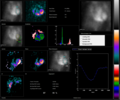A radionuclide (radioactive nuclide, radioisotope or radioactive isotope) is a nuclide that has excess numbers of either neutrons or protons, giving it... 31 KB (2,651 words) - 23:54, 22 April 2024 |
 | Nuclear medicine (redirect from Radionuclide test) nuclear medicine. 2D: Scintigraphy ("scint") is the use of internal radionuclides to create two-dimensional images. A nuclear medicine whole body bone... 39 KB (4,408 words) - 06:42, 6 May 2024 |
 | Radionuclide angiography is an area of nuclear medicine which specialises in imaging to show the functionality of the right and left ventricles of the... 17 KB (2,297 words) - 10:06, 8 August 2023 |
An extinct radionuclide is a radionuclide that was formed by nucleosynthesis before the formation of the Solar System, about 4.6 billion years ago, but... 7 KB (693 words) - 05:09, 7 April 2023 |
Radionuclide therapy (RNT, also known as unsealed source radiotherapy or molecular radiotherapy) uses radioactive substances called radiopharmaceuticals... 12 KB (1,305 words) - 09:39, 18 August 2023 |
A radionuclide generator is a device which provides a local supply of a short-lived radioactive substance from the decay of a longer-lived parent radionuclide... 5 KB (398 words) - 00:58, 4 December 2023 |
Cisternography (redirect from Radionuclide cisternogram) leak radionuclide cisternography also known as radioisotope cisternography is used. The third type of cisternography is MR cisternography. Radionuclide cisternography... 4 KB (393 words) - 09:16, 17 January 2024 |
 | Peptide receptor radionuclide therapy (PRRT) is a type of radionuclide therapy, using a radiopharmaceutical that targets peptide receptors to deliver... 28 KB (2,913 words) - 23:50, 4 March 2024 |
wastewater or brine. These naturally occurring radionuclides are of more concern than some man-made radionuclides used in fracture monitoring because of their... 25 KB (2,693 words) - 18:39, 27 April 2024 |
 | Primordial nuclide (redirect from Primordial radionuclide) processes. They are the stable nuclides plus the long-lived fraction of radionuclides surviving in the primordial solar nebula through planet accretion until... 24 KB (2,090 words) - 18:11, 18 April 2024 |
